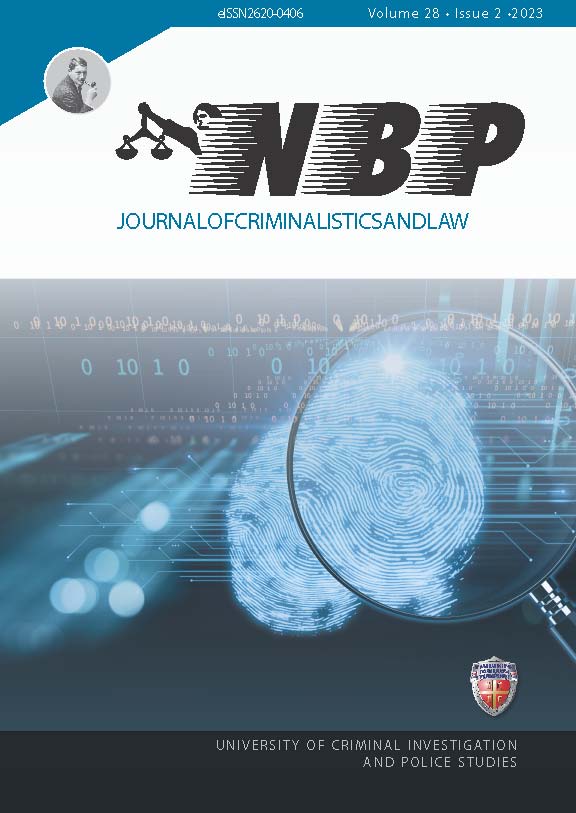The Role of the Internet in the Process of Radicalization in the Western Balkans
Abstract
In the past few decades Muslim extremists from the Western Balkans states have had a significant involvement in terrorist attacks in Europe. A number of extremists from Bosnia and Serbia recruited citizens from territories of former Yugoslavia and Europe to participate in the Syrian war. The increased radicalization in that part of Europe is a product of wars and the strong influence from Muslim countries on the local Muslim population. The research subject in this paper is the video material posted on YouTube in Bosnian and Serbian with the intention to radicalize the Muslim population from the Western Balkans. The analyzed video materials with radical messages were classified into two groups. Ones that aim at changing attitudes (cognitive radicalization) and the ones that propagate change in behaviour (engaging in violence, murder, terrorist acts, etc.)
References
Aly, A., (2010). Тhe Internet as Ideological Battleground. Australian Counter Terrorism Conference, Edith Cowan University, Perth.
Awan, A., N., (2007). Virtual jihadist media: Function, legitimacy and radicalizing efficacy. European Journal of Cultural Studies, Sage journals, 10(3), 389–408.
Berger, J. M. (2016). Making CVE work: A focused approach based on process disruption. The International Centre for Counter-Terrorism: The Hague, 7(5), 1–40.
Bright, D., Whelan, C., Hariss-Hogan, S., (2020). Exploring the hidden social networks of ''lone actor'' terrorists, Crime. Law and Social Change, Springer, 74(5), 491–508.
Dalgaard-Nielsen, A. (2010). Violent radicalization in Europe: What we know and what we do not know. Studies in conflict & terrorism, 33(9), 797–814.
Deliso, C., (2007). The Coming Balkan Caliphate: The Threat of Radical Islam to Europe and the West. Praeger Security International, London.
Dzhekova, R., Mancheva, M., Stoynova, N., & Anagnostou, D. (2017). Monitoring Radicalisation: A framework for risk indicators. Center for the Study of Democracy. (CSD), 34, 1–102.
Goldsmith, A., & Brewer, R. (2015). Digital drift and the criminal interaction order. Theoretical Criminology, 19(1), 112–130.
Holt, T., Freilich, J., Chermak, S., (2017a). Exploring the Subculture of Ideologically Motivated Cyber-Attackers. Journal of Contemporary Criminal Justice, Sage, 33(3), 212–233.
Holt, T., Freilich, J., & Chermak, S., (2017b). Internet-based radicalization as enculturation to violent deviant subcultures. Deviant behavior, 38(8), 855–869.
Holt, T., Freilich, J., Chermak, S., Mills, C., & Silva, J. (2019). Loners, colleagues, or peers? Assessing the social organization of radicalization. American Journal of Criminal Justice, 44(1), 83–105.
International Centre for the Prevention of Crime (ICPC), (2016). Crime Prevention and Community Safety: Cities and the New Urban Agenda. 5th International Report, Montreal.
Jowett, G.S., & O’Donnell, V., (2012). Propaganda and persuasion. 5th ed. Thousand Oaks, CA: SAGE.
Kladničanin, F. (2013) Vehabije u sajber prostoru. In: Jelinčić, J. & Ilić, S. (eds.) Politički ekstremizam u sajber prostoru Srbije. Zrenjanin: CRCD.
LaFree, G., (2017). Terrorism and the Internet. Criminology & Public Policy, 16(1), 93–98.
Macnair, L., & Frank, R. (2017), “To My Brothers in the West...”: A Thematic Analysis of Videos Produced by the Islamic State’s al-Hayat Media Center. Journal of contemporary criminal justice, 33(3), 234–253.
Mahood, S., & Rane, H. (2017). Islamist narratives in ISIS recruitment propaganda. The Journal of International Communication, 23(1), 15–35.
Marko, D. (1919). (Non)violent Extremism Online: How Opinion Leaders Use Online Channels to Disseminate Radical Messages and Intolerance. In Extremism and Violent Extremism in Serbia: 21st Century Manifestations of an Historical Challenge (Balkan Politics and Society).
McCauley, C., & Moskalenko, S. (2008). Mechanisms of political radicalization: Pathways toward terrorism. Terrorism and political violence, 20(3), 415–433.
Musial, J. (2016). “My Muslim sister, indeed, you are a mujahidah”-Narratives in the propaganda of the Islamic State to address and radicalize Western Women. An Exemplary analysis of the online magazine Dabiq. Journal for Deradicalization, (9), 39–100.
Neumann, P. R. (2013a). The trouble with radicalization. International affairs, 89(4), 873–893.
Neumann, P. R. (2013b). Options and strategies for countering online radicalization in the United States. Studies in Conflict & Terrorism, 36(6), 431–459.
Postel, T. (2013). The young and the normless: Al Qaeda’s ideological recruitment of Western extremists. Connections: The Quarterly Journal, 12(4), 99–117.
Prislan, K., Černigoj, A., & Lobnikar, B. (2018). Preventing radicalisation in the Western Balkans: The role of the police using a multi-stakeholder approach. Revija za kriminalistiko in kriminologijo, 69(4), 257–268.
Prodan, T., (2015). Internet, Terorizam, Protuterorizam. National Security and the Future, Zagreb 16(1), 93–143.
Richards, I. (2017). “Good and Evil” narratives in Islamic State media and Western government statements. Critical Studies on Terrorism, 10(3), 404–428.
Sivek, S., C., (2013). Packaging Inspiration: Al Qaeda's Digital Magazine Inspire in the Self-Radicalization Process. International Journal of Communication, Linfield College, McMinnville, (7),584–606.
Weiman, G., (2006). Terror on the Internet: The New Arena. The New Challenges, Woodrow Wilson Center Press, Washington.
Wiktorowicz, Q. (2005). Radical Islam rising: Muslim extremism in the West. Lanham: Rowman & Littlefield Publishers.

